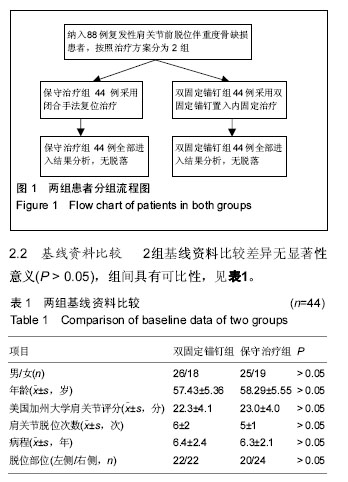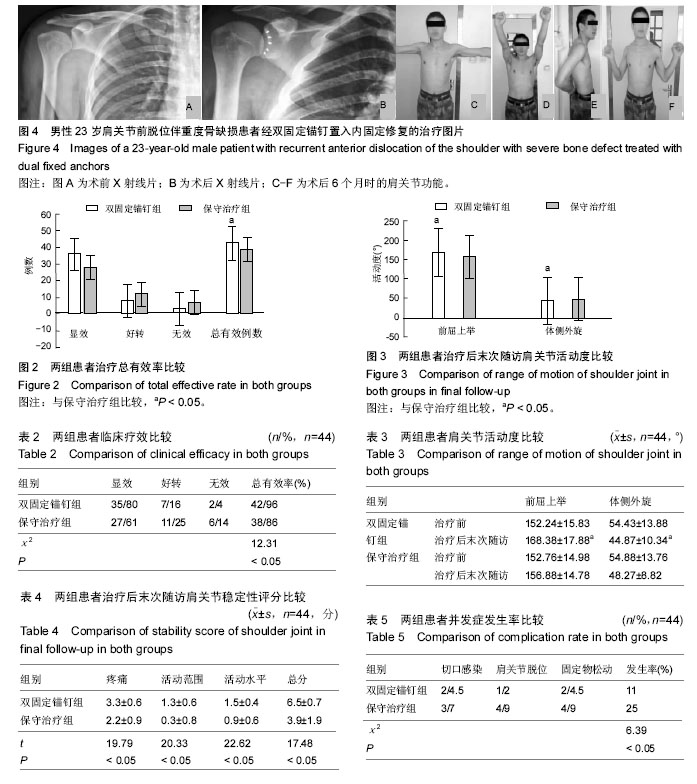| [1] 田荣利,罗国强,彭熠.肩关节脱位手法复位临床研究现状与展望[J]. 中医正骨志,2004,16(12):60-61.
[2] 单连成,左冬青,华莹奇,等.肩关节脱位外旋固定疗效的meta分析[J]; 同济大学学报(医学版),2014,35(5): 56-61.
[3] Stijak L,Radonjic V,Nikolic V,et al.The position of anterior cruciate ligament in frontal and sagittal Plane and its relation to the inner side of the lateral femoral condyle. Knee Surg Sports Traumatol Arthrose. 2009; 17:887-894.
[4] 党育,付中国,芦浩,等. 关节镜治疗肩关节脱位合并肱骨大结节骨折近期疗效[J]. 中国修复重建外科杂志, 2009, 23(3):271-273.
[5] 张朝春,郑章平,徐皓.军训致复发性肩关节脱位原因分析[J]. 东南国防医药,2010,12(3):157-158.
[6] 徐斌,涂俊. 关节镜下盂唇修补与关节囊复合部分肩胛下肌紧缩修复复发性肩关节前脱位[J]. 中国组织工程研究, 2015,19(11):1739-1744.
[7] 牛晓健,聂润华,陈周生. Stimson配合Hippocrates法复位治疗肩关节脱位[J]. 实用骨科杂志,2013,19(8):741-742.
[8] 许文杰,沈为栋,张铁洪,等.早期关节镜下钢丝穿套治疗胫骨髁间嵴骨折20例体会[J].中国内镜杂志,2007,13(8): 857-858.
[9] 徐又佳,周海滨,周正明,等.关节镜下双钢丝牵引固定钢丝法修复膝前交叉韧带撕脱骨折临床操作要点[J]. 中国矫形外科杂志,2006,16(4):244-248.
[10] 陈辉,王群,燕双喜,等.关节置换与关节镜下修复肩关节复发性前脱位伴重度骨缺损: 3年随访对比[J].中国组织工程研究,2015,19(35):5625-5629.
[11] Robinson CM,Seah M,Akhtar MA. The epidemiology,risk of recurrence,and functional outcome after an acute traumatic posterior dislocation of the shoulder. J Bone Joint Surg Am. 2011;93(17):1605-1613.
[12] 易建华,牛晓锋,周玉萍. 复发性肩关节前脱位的关节镜下治疗[J]. 中国骨与关节损伤杂志,2014,29(3):286-287.
[13] Chae SW,Kim SY,Lee H,et al. Effect of baseplate size on primary glenoid stability and impingement-free range of motion in reverse shoulder arthroplasty.. BMC Musculoskelet Disord. 2014;15(1):417.
[14] 叶永平,符臣学,张朝春,等.肩关节复发性前脱位的手术治疗[J]. 福州总医院学报,2006,13(1): 52-53.
[15] 郑华伟,黄富国. 肩关节前方不稳的外科治疗进展[J]. 华西医学,2007,22(4): 939.
[16] 潘孝云,陈成旺,温宏,等.关节镜下双排缝合桥固定技术治疗冈上肌肌腱破裂[J].中医正骨,2014,26(2):32-33.
[17] Hovelius L,Sandström B,Olofsson A,et al. The effect of capsular repair, bone block healing, and position on the results of the Bristow-Latarjet procedure (study Ⅲ): long-term follow-up in 319 shoulders. J Shoulder Elbow Surg. 2012; 21(5):647-660.
[18] Day JS, Ramsey ML, Lau E, et al. Risk of venous thromboembolism after shoulder arthroplasty in the Medicare population. J Shoulder Elbow Surg. 2015; 24(1):98-105.
[19] 朱建辛.16例陈旧性肩关节脱位合并肱骨头骨缺损的治疗分析[J].中国中医药咨讯,2011,3(12):4-5.
[20] 俞霞,葛国芬,金红.关节镜下肩袖修补术后早期分时康复干预的效果[J].浙江临床医学,2014,9(12):1517-1518.
[21] 宁凡友,张作君,牛素玲,等. 改良Bristow-Latarjet术治疗复发性肩关节前脱位[J].中医正骨, 2014,26(7):30-31.
[22] 田大庆,赵辉,王军,等. 肩关节复发性脱位的诊疗进展[J]. 中华全科医学,2009,7(3):305-307.
[23] 谢娟,陈刚,曾明,等.关节镜下双排缝合桥技术治疗肩袖全层撕裂伤术后的综合康复治疗[J].中华物理医学与康复杂志,2014,36(5):376-380.
[24] 杨国勇,向明,陈杭,等,Latarjet手术治疗癫痫患者复发性肩关节前脱位伴重度骨缺损的短期疗效分析[J]. 中华肩肘外科电子杂志,2014,2(2):91-96.
[25] Zwetyenga N,Catros S,Emparanza A,et al. Mandibular reconstruction using induced membranes with autologous cancellous bone graft and HA-betaTCP: animal model study and preliminary results in patients. Int J Oral Maxillofac Surg. 2009; 38(12): 1289-1297.
[26] 安佰京,邢更彦.关节镜下Pushlock免打结技术治疗复发性肩关节不稳临床效果分析[J]. 中国医学前沿杂志(电子版),2011,2(28):488-490.
[27] 唐志斌,陈志伟,邓焱,等.关节镜下治疗复发性肩关节前脱位的临床疗效[J]. 中南医学科学杂志,2013,41(4): 392-394.
[28] 韩天宇,祖启明,项良碧,等.改良Boytchev法治疗复发性肩关节前脱位[J]. 临床骨科杂志,2008,11(6):519-520
[29] Hollevoet N,Vanhoutie T,Vanhove W,et al. Percutaneous K-wire fixation versus palmar plating with locking screws for Colles′ fractures. Acta Orthop Belg. 2011;77(2):180-187.
[30] 乔伟松,张晓南,宁漱岩,等.关节镜下GⅡ锚钉治疗中老年创伤性肩关节脱位合并Bankart损伤[J]. 中国老年学杂志,2014,30(17):2509-2510.
[31] 肇刚,刘玉杰.盂肱关节不稳定的最新诊治进展[J]. 中国骨伤,2014,27(2):172-175.
[32] Labudzynskyi DO,Lisakovska OA,Shymanskyy IA,et al. The role of vitamin D3 in the regulation of the mineral metabolism in experimental type 1 diabetes. Biomed Khim. 2014;60(5): 567-575. |
.jpg)


.jpg)